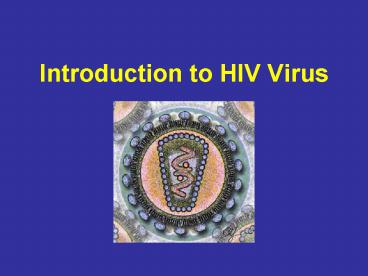Introduction to HIV Virus PowerPoint PPT Presentation
1 / 19
Title: Introduction to HIV Virus
1
Introduction to HIV Virus
2
What is HIV?
- Human Immunodeficiency Virus
- Composed of 9 genes
- Bacteria typically have 5000 genes
- Humans have 20,000-25,000 genes
3
Structure of HIV
- 2 identical copies of single strands of RNA
- Surrounded by viral Envelope of fatty material
- On viral envelope are 72 spikes composed of
proteins gp120 and gp 41
gpglycoprotein number is molecular weight
(daltons)
4
- Beneath is a viral matrix composed of protein p17
- RNA is surrounded by a capsid of protein p24
5
- Also contains 3 enyzmes needed for HIV
replication - Reverse transcriptase
- Integrase
- Protease
6
HIV Infection and Replication
7
Entry
- HIV Spikes (Ligand) g120/41
- Must Attach to at least two Receptors on Helper
T-lymphocytes - CD4
- 7-transmembrane receptor
- HIV Ligand is the Key to Unlock the Receptor on
the CD4 T cell
8
- Releases contents into CD4 or Helper T-Cell
9
Reverse Transcription and Integration
- HIV enzyme reverse transcriptase converts viral
RNA to DNA - Makes copying errors
- Leads to variations in HIV
- New viral DNA is spliced into human DNA by HIV
enzyme integrase
10
Transcription and Translation
- Viral DNA lies dormant until T-cell is activated
- Human DNA with viral DNA (provirus) now makes
messenger RNA (human and viral) - Translated at ribosomes to make new HIV proteins
11
Assembly
- New long Viral polypeptide chain is chopped up
into smaller pieces by protease - Creating new enzymes and viral coat proteins
12
Budding and Maturation
- Assembles all viral components
- Buds from host cell
- Takes a piece of the host plasma membrane
13
Effect on Immune System
- Activates Helper T-Cell The General
- Secretes Cytokines which
- Activate macrophages, cytotoxic or killer
T-cells, and natural killer cells - Control maturation and induction of
antibody-producing B cells - Secrete colony stimulating factors for more white
blood cells
14
1st Stage of Infection -Primary
- Rapid viral replication
- Patient exhibits flu-like symptoms
- Undergoing Seroconversion
- B-cells making antibodies
- Patient is infectious but will not test for
HIV
15
2nd Stage of Infection-Clinical Latency
- Strong immune defense to that particular variant
of HIV - Reduced number of viruses
- Lasts 2 weeks -20 years
- Patient still infectious
- Will test for HIV
16
3rd Stage of InfectionAIDS
- Virus has mutated
- T-cells and B-cells are activating against all
the different variants of HIV - Helper T-cells are dying
- Bone marrow cant make new cells fast enough
- Immune System is overloaded and compromised
17
- Normal count 800-1200 cells/ul
- If CD4 T cell count drops below 200 cells /ul
- patient has AIDS
- patient is susceptible to opportunistic
infections.
18
Types of Drugs Used on HIV
- Reverse Transcriptase Inhibitors
- AZT blocks recoding of viral RNA into DNA
- Protease Inhibitors
- Blocks protease that cleaves viral polypeptide
into functional enzymes - Best regimen is cocktail of both types of drugs
19
The End

